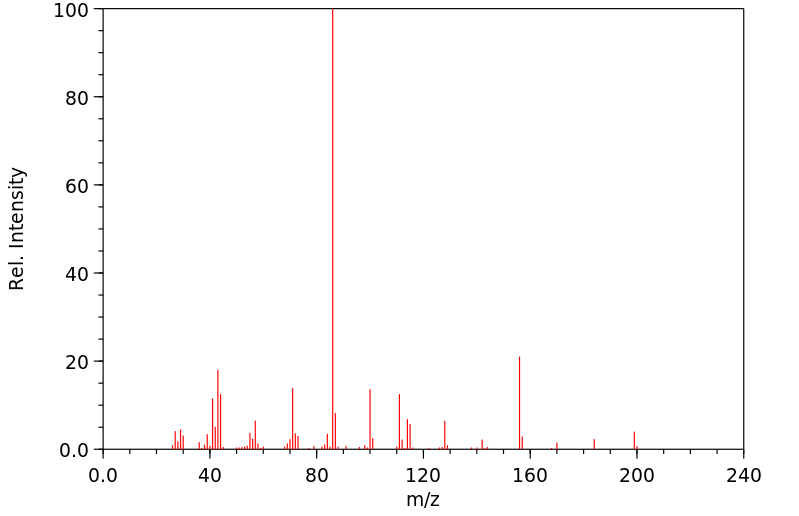N,N-二丁基丁酰胺 | 14287-95-7
中文名称
N,N-二丁基丁酰胺
中文别名
——
英文名称
N, N-di-n-butyl-butyramide
英文别名
N,N-(di-n-butyl)butyramide;N,N-dibutylbutanamide;N,N-dibutylbutyramide;DBBA;DBB;N,N-dibutyl-butyramide;Butyramide, N,N-dibutyl-
CAS
14287-95-7
化学式
C12H25NO
mdl
MFCD01340063
分子量
199.337
InChiKey
YIGDAUZSYXKBHT-UHFFFAOYSA-N
BEILSTEIN
——
EINECS
——
-
物化性质
-
计算性质
-
ADMET
-
安全信息
-
SDS
-
制备方法与用途
-
上下游信息
-
文献信息
-
表征谱图
-
同类化合物
-
相关功能分类
-
相关结构分类
物化性质
-
保留指数:1437
计算性质
-
辛醇/水分配系数(LogP):3.1
-
重原子数:14
-
可旋转键数:8
-
环数:0.0
-
sp3杂化的碳原子比例:0.916
-
拓扑面积:20.3
-
氢给体数:0
-
氢受体数:1
安全信息
-
海关编码:2924199090
SDS
反应信息
-
作为反应物:描述:参考文献:名称:Fritz,H. et al., Bulletin des Societes Chimiques Belges, 1978, vol. 87, p. 525 - 534摘要:DOI:
-
作为产物:参考文献:名称:铁催化的Cα ?在温和条件下将脂肪族叔胺H氧化为酰胺摘要:从头合成酰胺经常会产生化学计量的废物。因此,该领域的最新进展集中在贵金属催化的氧化方案上,以产生这种功能。然而,简单的叔烷基胺不能用作这些方案中的起始原料。研究本文所述使酰胺的从简单的氧化合成,非环状叔烷基通过仿生方法合成是有用的,温和的条件下的胺:铁-催化的C ^ α ħ官能化。机械调查洞察反应中间体和允许温和的C的发展α H氰化法采用相同的催化剂体系。该方案进一步应用于氧化药物利多卡因,证明了所开发的化学方法可用于代谢产物的潜在用途。DOI:10.1002/anie.201507738
-
作为试剂:描述:参考文献:名称:Ismail,R.M., Journal fur praktische Chemie (Leipzig 1954), 1970, vol. 312, p. 389 - 393摘要:DOI:
文献信息
-
Iron-Catalyzed Oxidative Amidation of Tertiary Amines with Aldehydes作者:Yuanming Li、Fan Jia、Zhiping LiDOI:10.1002/chem.201203824日期:2013.1.2A new oxidative coupling protocol for amide bond formation has been developed (see scheme). The method provides an efficient and practical route for the synthesis of tertiary amides from readily available tertiary amines and aldehydes in the presence of a simple FeCl2 catalyst. Mechanistic studies indicated that a peroxide and an iminium ion act as the reactive intermediates in this oxidative amidation非常规偶合:已经开发了用于酰胺键形成的新的氧化偶合方案(参见方案)。该方法为在简单的FeCl 2催化剂存在下由容易获得的叔胺和醛合成叔酰胺提供了一种有效而实用的途径。机理研究表明,在该氧化酰胺化反应中,过氧化物和亚胺离子是反应性中间体。
-
Catalyst-free amidation of aldehyde with amine under mild conditions作者:Hongyin Yang、Wenjian Hu、Shengjue Deng、Tiantian Wu、Haiman Cen、Yiping Chen、Dela Zhang、Bo WangDOI:10.1039/c5nj01372k日期:——
A highly efficient, catalyst-free and one-pot procedure for the direct synthesis of amides from aldehydes and amines under mild conditions has been developed.
一种高效、无催化剂且一锅法的程序已经开发出来,可在温和条件下直接合成酰胺,使用的原料是醛和胺。 -
A Facile One-Pot Transformation of Carboxylic Acids to Amides作者:Jong Chan Lee、Yoon Hwan Cho、Hyeok Koo Lee、Sung Hye ChoDOI:10.1080/00397919508011836日期:1995.9Abstract Carboxylic acids, converted in situ into carboxylic-(p-nitrobenzene)sulfonic anhydrides using p-nitrobenzenesulfonyl chloride, Et3N, and DMAP in CH3CN, react with primary or secondary amines, to give amides in high yields.
-
Spectrophotometric Analysis of Ternary Uranyl Systems to Replace Tri-N-butyl Phosphate (TBP) in Used Fuel Reprocessing作者:Adam J. Canner、Laurence M. Harwood、Joseph Cowell、Jasraj S. Babra、Solomon F. Brown、Mark D. OgdenDOI:10.1007/s10953-019-00942-7日期:2020.1monoamides were found to be independent of amine-side chain length, but were slightly dependent on the carbonyl-side chain length. TEDGA was found to produce multiple uranyl complexes in solution. Job plot data indicated that the uranyl cation strongly prefers to bond either only with the monoamide or diamide in ternary monoamide–diamide–UO2 systems. Monoamide–diglycolamide–UO2 systems were more complicated在本报告中,单酰胺/二酰胺和单酰胺/二甘醇酰胺混合物与 UO22+\documentclass[12pt]minimal} \usepackageamsmath} \usepackagewasysym} \usepackageamsfonts} \usepackageamssymb} \usepackageamsbsy} 的相互作用\usepackagemathrsfs} \usepackageupgreek} \setlength\oddsidemargin}-69pt} \begindocument}$$\textUO}}_2}^2 + }$$\enddocument}在 pH = 1 的甲醇硝酸介质中进行研究。这些单酰胺包括 N,N-二甲基乙酰胺 (DMAA)、N,N-二乙基乙酰胺 (DEAA)、N,N-二丁基乙酰胺 (DBAA) 和 N,N-二丁基丁酰胺
-
Using dialkyl amide <i>via</i> forming hydrophobic deep eutectic solvents to separate citric acid from fermentation broth作者:Lijuan Liu、Qifeng Wei、Yong Zhou、Xiulian RenDOI:10.1039/c9gc04401a日期:——traditional calcium salt method which produces a large amount of waste gypsum residue, a new way of separating citric acid from fermentation broth was developed by forming hydrophobic deep eutectic solvents (DESs), in which amide and citric acid were used as the hydrogen bond acceptor and donor respectively when amide was in contact with the fermentation broth containing citric acid. Among these amides如今,开发适当的技术是社会减少环境影响的最大挑战之一。在这项研究中,为避免传统的钙盐方法产生大量的石膏废渣,通过形成疏水性深共熔溶剂(DESs)(其中酰胺和柠檬酸为二氯乙烷),开发了一种从发酵液中分离柠檬酸的新方法。当酰胺与含柠檬酸的发酵液接触时,分别用作氢键受体和供体。在这些酰胺中,C 10 H 21根据分子大小和形状,发现NO是与柠檬酸形成疏水性DES的有效氢键受体,其最大疏水平衡常数为3.14。通过使用FT-IR和量子化学(QC)计算分析化学键,研究了疏水性DES的形成机理。通过升高疏水性DES的温度来再生C 10 H 21 NO。再生的C 10 H 21 NO表现出良好的再循环特性,而形成疏水性DES的能力没有明显降低。这种获得高质量柠檬酸的有效方法为分离其他羧酸提供了新思路。
表征谱图
-
氢谱1HNMR
-
质谱MS
-
碳谱13CNMR
-
红外IR
-
拉曼Raman
-
峰位数据
-
峰位匹配
-
表征信息
同类化合物
(±)17,18-二HETE
(±)-辛酰肉碱氯化物
(Z)-5-辛烯甲酯
(Z)-4-辛烯酸
(R)-甲羟戊酸锂盐
(R)-普鲁前列素,游离酸
(R,R)-半乳糖苷
(E)-4-庚烯酸
(E)-4-壬烯酸
(E)-4-十一烯酸
(9Z,12E)-十八烷二烯酸甲酯
(6E)-8-甲基--6-壬烯酸甲基酯-d3
(3R,6S)-rel-8-[2-(3-呋喃基)-1,3-二氧戊环-2-基]-3-羟基-2,6-二甲基-4-辛酮
龙胆二糖
黑曲霉二糖
黄质霉素
麦芽酮糖一水合物
麦芽糖醇
麦芽糖酸
麦芽糖基蔗糖
麦芽糖一水合物
麦芽糖
鳄梨油酸乙酯
鲸蜡醇蓖麻油酸酯
鲸蜡醇油酸酯
鲸蜡硬脂醇硬脂酸酯
鲸蜡烯酸脂
鲸蜡基花生醇
鲫鱼酸
鲁比前列素
鲁比前列素
高级烷基C16-18-醇
高甲羟戊酸
高效氯氰菊酯
高-gamma-亚油酸
马来酸烯丙酯
马来酸氢异丙酯
马来酸氢异丁酯
马来酸氢丙酯
马来酸氢1-[2-(2-羟基乙氧基)乙基]酯
马来酸单乙酯
马来酸单丁酯
马来酸二辛酯
马来酸二癸酯
马来酸二甲酯
马来酸二烯丙酯
马来酸二正丙酯
马来酸二戊基酯
马来酸二异壬酯
马来酸二异丙酯







